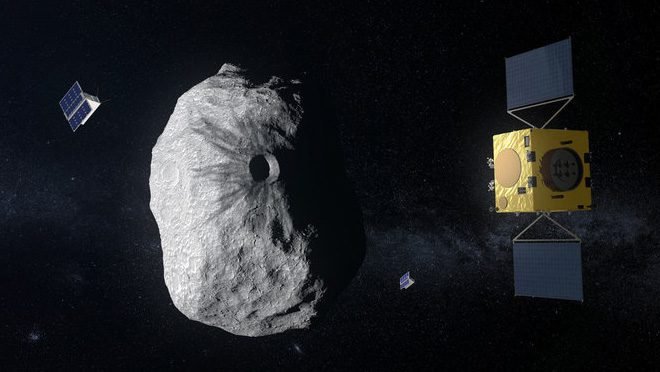Asteroid researchers and spacecraft engineers will gather in Rome next week for a three day International AIDA workshop will be held from September 11 to 13 in the historic surroundings of the ‘Aula Ottagona’ in central Rome, part of the Baths of Emperor Diocletian which went on to serve as a planetarium in the last century.

Participants will be coming from Europe, Us and all over the world to discuss a double-spacecraft mission that promises to deflect an asteroid in space to prove the technique as a viable method of planetary defense.
The agenda of this meeting will be to discuss the current progress of the two spacecraft which are being built by AIDA. These include the smaller nano-spacecraft that they will carry them aboard. The participants will also discuss the latest results of global astronomical campaigns undertaken to learn more about the distant Didymos asteroids.
Didymos is a near-Earth asteroid body which is selected as a target. It’s main body measures about 780 m across and its moonlet is about 160 m in diameter which has a similar size of Egypt’s Great Pyramid.
An ESA report points out, “due to the relatively small mass and gravities of these bodies, the smaller asteroid orbits its parent at a comparatively low velocity of a few centimeters per second, making it feasible to shift its orbit in a measurable way – something which would not be achievable so precisely with a lone asteroid in a much more rapidly moving solar orbit”.
NASA has reportedly contributed a couple of experiments to AIDA including the Double Asteroid Impact Test and the DART spacecraft. The DART spacecraft is already under construction for launch in summer 2021 and aims to collide with its target at 6.6 km/s in September 2022. A Light Italian CubeSat or LICIACube will be attached to it to record the moment of impact.
According to an ESA report, their much-awaited mission, Hera will include a close-up survey of the post-impact asteroid, acquiring measurements such as the asteroid’s mass and detailed crater shape. This spacecraft will also deploy a pair of CubeSats to perform close-up asteroid surveys. It will also act as the very first radar probe of an asteroid.
The current status proves that Hera is currently undergoing final phase B2 design work. Its’s final fate is yet to be decided in the Space 19+ Ministerial Conference by Europe’s space ministers in November 2019. Hera will be a part of the new ESA Space Safety Programme. However, the launch of Hera is scheduled in October 2024 and the journey may take about two years to complete.
Researchers will try to improve the efficiency of the collision using the results provided by Hera “to turn this grand-scale experiment into a technique which could be repeated as needed in the event of a real threat”.
Ian Carnelli, Manager of Hera has expressed his concerns on this ambitious project in an ESA report.
DART can perform its mission without Hera – The effect of its impact on the asteroid’s orbit will be measurable using Earth ground-based observatories alone. But flying the two missions together will greatly magnify their overall knowledge return. Hera will, in fact, gather essential data to turn this one-off experiment into an asteroid deflection technique applicable to other asteroids. Hera will also be the first mission to rendezvous with a binary asteroid system, a mysterious class of object believed in making up around 15% of all known asteroids.
He is indeed hopeful of the success of the mission as they have provided Hera a bunch of ultra-modern technologies which will boost up the performance of the spacecraft.
And our mission will test a variety of important new technologies, including deep space CubeSats, inter-satellite links and autonomous image-based navigation techniques, while also providing us with valuable experience of low-gravity operations. I also believe it is vital that Europe plays a leading role in AIDA, an innovative mission originally developed through ESA research back in 2003. An international effort is the appropriate way forward – planetary defense is in everyone’s interest.
If the mission sees the light of success then it will surely open up a new path in terms of our Space security. We can hope that scientist will crack a breakthrough with the results of the upcoming missions to protect us from the extraterrestrial things.




